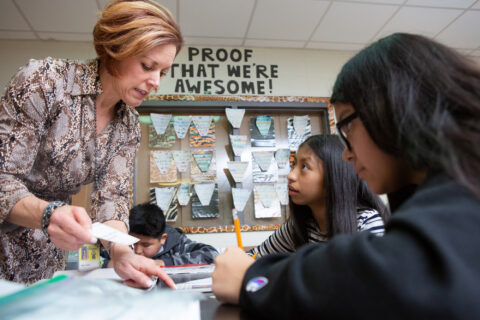My District Had a High-Quality Curriculum. Then COVID-19 Happened.
Educator Jamilah Hicks shares her story as a parent coping with remote learning when students don’t have access to the materials they need.
Education is in my blood. My mom has been a substitute teacher in Baton Rouge for as long as I can remember, and both of my parents have emphasized the importance of learning to each person in the family. From a young age, all of my volunteer work or first jobs involved working with children—it was of little surprise to anyone when I became a teacher. I have spent more than 18 years in education with roles ranging from kindergarten teacher to district leadership before joining EdReports as an ELA content specialist.
But even with all my years as an educator, I’ve never dealt with anything like the COVID-19 pandemic. I was unprepared for the impact of the virus on the 30,000 students in Lafayette Parish School System district where I used to teach, where my husband still teaches, and where my son and daughter continue to attend school. As schools closed down suddenly last spring, our district, like most districts, scrambled to figure out what to do next with no shortage of challenges. Some schools in our district are in rural areas with little access to the internet. We serve a high percentage of free and reduced lunch students who rely on school for nutrition and critical services. We also have a growing population of English learners who depend on a variety of learning supports.
"Instead of using a standards-aligned curriculum designed with coherent content, our students and families were forced to bear the overwhelming burden of juggling disjointed lessons."
As a former administrator, I deeply empathize with the challenges faced by the school district. But as a parent and lifelong educator I was deeply concerned about a decision made by the district in the spring that research shows will set our students even further back. They abandoned the recently adopted high-quality English language arts program (with extensive digital components) for paper packets and a hodgepodge of online resources. Instead of using a standards-aligned curriculum designed with coherent content, our students and families were forced to bear the overwhelming burden of juggling disjointed lessons.
New Year, Same Challenges
Despite the difficulties of the spring, I had hopes for the new school year. The district had more time to plan for remote and hybrid learning in the fall—families were expecting a much-improved experience. Because of my time in education, I knew how important it would be for all the students to have access to quality, aligned instructional materials as school began again. Materials are key to addressing COVID-created gaps and accelerating learning. They are also vital supports to parents and teachers as we strive to ensure students do not continue to get even further behind.
"Materials are key to addressing COVID-created gaps and accelerating learning."
That’s why I was alarmed when the district made the choice again to abandon the already adopted aligned ELA materials and decided to switch to an unvetted remote platform as its option for virtual learning. When I was an administrator, I witnessed this same platform used in the district’s alternative schools. Not only did it fail to address academic gaps, but the lack of grade-level content aligned to the core curriculum actually created new gaps and made it more difficult for students to reintegrate into their regular classrooms.
Using unvetted resources for any of our students was already an inequitable choice. Now, at a time when learning loss is at an all time high, students in the district learning remotely will be placed at a disadvantage because they will not have access to the high-quality content that can make a difference.
What We Choose Matters
As someone who has worked at the leadership level, I know these choices are not easy. I understand that if we use the adopted ELA program that we may not have enough anchor texts for all students. I understand that planning to deliver lessons in an entirely new way is complicated and that unexpected issues crop up every day. I understand that expedience and cost-efficiency are tempting and sometimes unavoidable considerations. But when the supposed convenience of a platform rather than the quality of the content guides decisions, we solve short term problems at the expense of long term consequences.
"...quality support and content for teachers and students must be prioritized even if that requires innovation and more work on our part."
Whether there’s a pandemic or not, quality support and content for teachers and students must be prioritized even if that requires innovation and more work on our part. What we choose (and actually USE) matters. How will these materials ensure all students are prepared for college and career? How will these materials impact mastery of standards? How will the content support the scope and sequence? And how will the choice of materials affect student growth moving forward? We must remember that what happens in a single year or grade level is not confined to a handful of months. What students learn or don’t has ripple effects for years in the future.
Use Your Voice
I’m certain that I’m not the only parent or educator struggling with decisions I did not make. But what can you do if you find yourself in a similar position? Here are three specific actions you can take to advocate for your student:
- Understand that programs are not interchangeable. If your child’s school or district has made an abrupt switch in instructional materials, do not assume that the new materials are aligned to college and career-ready standards or that they will meet the needs of your community. Properly vetting curriculum takes time even with the urgency of the pandemic. Recognizing that materials matter may seem small but is in fact a significant step in ensuring students and teachers have the support they need.
- Stay informed about the choices your district is making and what those choices mean. Being equipped with knowledge allows you to better understand the consequences of choices. Having the right information also means you can start to gather the tools to advocate for quality options. EdReports reviews of instructional materials offer independent information about the alignment and quality of specific programs. Additionally, we offer a suite of resources which aim to support parents and educators to learn more about how students are impacted by the content they have access to.
- Advocate for students. As parents and educators, if we know our students do not have access to the materials they need for success, we can take action. With the information you gather, talk to teachers, principals, and district leaders. Attend school board meetings and voice your concerns. Our resources include advice for how educators and community members can advocate for high-quality, aligned instructional materials.
We are often more powerful than we believe. I learned this first from my own parents who instilled in me a deep belief that education can transform lives. They also taught me the importance of using my gifts to serve others. And they were right in so many ways. It’s why I’ve dedicated my efforts to ensuring the same promise of education is still possible for my own kids, for the students in Lafayette Parish, and for all students in classrooms across the country.
Related Resources




